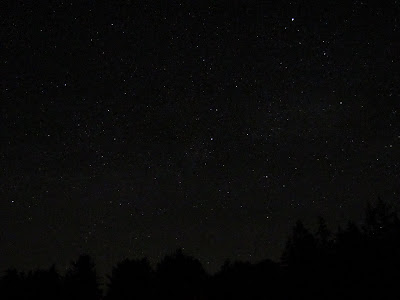What is a star party?
Star parties are gatherings in which many astronomers will observe the night sky together, usually in an open field far away from the city lights. The meets usually last an entire night, although meets lasting several nights to an entire week are common. The number of participants at a star party varies from a dozen to hundreds, depending on location, weather conditions, and other factors.
What happens at a star party?
Activities at star parties usually involve looking through telescopes or binoculars at objects beyond our Solar System--stars, nebulae, globular clusters, galaxies, and more. New to the hobby? Then attend a star party. New astronomers will have a chance to expand their knowledge on the hobby. Veteran astronomers will be there to help and answer questions.
At larger star parties, participants can expect guest speakers (from NASA, telescope manufacturers, astronomy magazines, etc.) providing presentations covering our solar system, interstellar neighborhood, galaxy, and the universe as a whole. Participants can also expect prizes at larger star parties, donated by astronomy retailers and manufacturers. Prizes given are usually eyepieces, telescope kits, filters, etc.
Where are star parties located?
Due to the issue of light pollution near urban and suburban developments, star parties are usually held in remote locations. There are exceptions, however; some star parties are located closer to urban centers in order to attract local participants. Events are usually held in state parks, private camps, and club-owned observatory sites. The key ingredient to the location is dark skies.
What expectations are there?
There are a few expectations set in stone by astronomers for an orderly observing night; the most important to note concerns white lights. Due to the sensitivity of the human eye, any emission of artificial light, using common flashlights, will reduce the astronomer's ability observing the faintest of stars. The only flashlights permitted at star parties are those emitting red-spectrum light. White flashlights are not tolerated.
For those bringing their kids along, it is recommended to keep an eye on them. Pets are generally not allowed at star parties. No one wants to listen to dogs barking and howling all through the night, and pets don't always get along with one another.
What to bring?
Regardless of the location, veteran astronomers will recommend bringing spare clothes--flannel shirts, sweatshirts, jackets, or hooded jackets. The extra clothes will prove necessary as temperatures drop during the night. It is recommended to wear layers when spending an entire night observing the night skies.
Other items to consider bringing along include food and beverages, nothing too complicated though. A few water bottles and some dry snacks should be enough, if observing for one night. Should the star party last for several days, however, options may vary, depending on location. There are a select few star parties where restaurants are within driving distance. In most cases, restaurants are out of the question, due to remote locations. However, some of the larger, more organized star parties include food vendors on site.
Assuming there's a combination of interests (astronomy and camping), recommendations suggest the astronomer should bring along camping equipment--tent, stakes, camping chairs, etc. And as stated before, bringing conventional flashlights is out of the question. In place of a traditional white-beam flashlight, astronomers suggest bringing along a red-spectrum flashlight. It may not be as bright as a conventional flashlight, but its bright enough to see what the observer is doing.



















